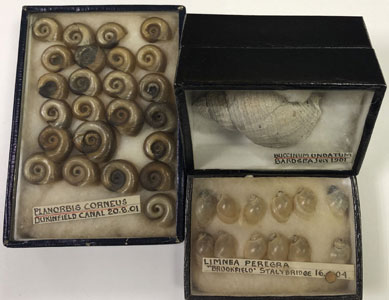Shells
Tameside Museums has over 3300 little boxes of historic shells from all over the world. The little boxes were collected and put together by Charles Moore (1869-1949) who also collected the eggs in the museum collections.
Lots of animals live in shells and these provide essential protection from predators. Some large vertebrate (with a backbone) creatures such as turtles and armadillos have shells but most creatures that have shells are invertebrate (without a backbone). Some examples are crabs, clams, mussels and snails.
There are lots of snail shells in our collections. Snails are really fascinating creatures.
Did you know?
***There are 40,000 species of snail in the world, second only to insects for their number of named species.
***There are land snails, sea snails and freshwater snails
***The largest land snail is ‘the giant Ghana’ snail and it can grow up to 12 inches long!

Two of these boxes of shells were collected locally in Dukinfield and Stalybridge – Planorbis corneus and Limnea peregra are both types of freshwater snail. The larger shell called Buccinum undatum is also known as the common whelk and this was found in Bardsea in the Lake District.

This photograph shows a much larger type of snail shell from Mexico.

These shells were collected by Alfred Bradbury from Dukinfield. Alfred taught at All Saints School in Dukinfield after serving in the Royal Engineers during the Second World War. The outdoors always interested Alfred and he regularly made trips to Congleton to spend time observing nature. He made his own wine using fruit he collected on his trips ,and was also a keen bee keeper. Alfred built up a varied collection of shells from his many journeys abroad. The first ones came from the Seychelles while others came from The Grand Canyon in California. Alfred died in 1998 and his collection was donated to the museum.

